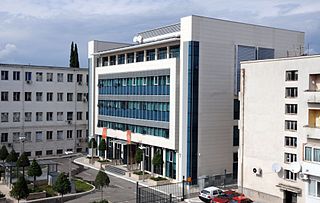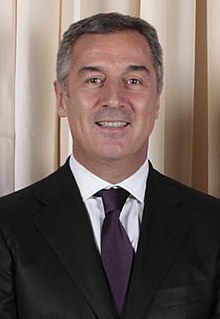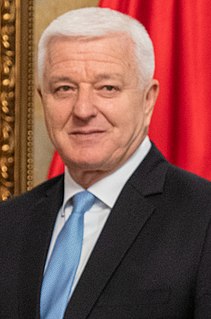 W
WThe Government of Montenegro is the executive branch of state authority in Montenegro. It is headed by the prime minister. It consists of the prime minister, the deputy prime ministers as well as the ministers.
 W
WThe Deputy Prime Minister of Montenegro, officially Vice President of the Government of Montenegro, is the official Deputy of the Prime Minister of Montenegro.
 W
WThe fifth cabinet of Milo Đukanović was the cabinet of Montenegro from 29 February 2008 to 29 December 2010. It was a coalition government composed of Coalition for a European Montenegro and Democratic Union of Albanians.
 W
WThe sixth cabinet of Milo Đukanović was the cabinet of Montenegro from 4 December 2012 to 28 November 2016. It was a coalition government composed of centre-left Coalition for a European Montenegro and national minority parties. Split in the ruling DPS-SDP coalition in January 2016, leaving the government functioning as a de facto minority government. The Cabinet was functioning as the provisional government , from 12 May to 28 November 2016, with several Ministers from opposition parties joined the government.
 W
WIn a referendum on 21 May 2006, the people of Montenegro opted to leave the State Union of Serbia and Montenegro. This result was confirmed with a declaration of independence by the Montenegrin parliament on 3 June 2006. It simultaneously requested international recognition and outlined foreign policy goals.
 W
WThe Cabinet led by Zdravko Krivokapić, is the 42nd cabinet of Montenegro. Krivokapić Cabinet was elected on 4 December 2020 by a majority vote in the parliament. The technocratic government is composed of independents and is supported by the four parliamentary groups; Democratic Front, Peace is Our Nation, Socialist People's Party and the Civic Movement URA.
 W
WThe Lukšić Cabinet, led by Igor Lukšić, is the 39th cabinet of the Montenegro. The cabinet was elected on 29 December 2010 by a majority vote in Montenegrin Parliament. It succeeded the sixth cabinet of Milo Đukanović. formed after the 2009 parliamentary election, after Đukanović resigned the prime minister. The coalition government was composed of the Democratic Party of Socialists (DPS), the Social Democratic Party (SDP), and ethnic minority parties.
 W
WIgor Lukšić is a Montenegrin politician who served as the 4th Prime Minister of Montenegro from 2010 to 2012, following the resignation of Milo Đukanović. He was succeeded by Đukanović on 4 December 2012 and served as Minister of Foreign Affairs in the latter's fourth cabinet, from 2012 to 2016. Presently Lukšić is with PwC and handles public sector activities in southeast Europe. He is expected to become Secretary General of the Regional Cooperation Council as of 1 January 2022.
 W
WThe Marković Cabinet, led by Duško Marković, is the 41st cabinet of the Montenegro. Cabinet was elected on 28 November 2016 by a majority vote in the Parliament of Montenegro. The coalition government was composed of the Democratic Party of Socialists, the Social Democrats, and ethnic minority parties. Cabinet lasted until December 2020, and represents the eleventh and the last cabinet during the DPS-led regime in Montenegro that has been in power since 1990 and the establishment of the multi-party system in country.
 W
WThe Montenegrin passport is the primary document of international travel issued by Montenegro.
 W
WThe National Security Agency is the national intelligence agency of Montenegro. Its headquarters are located in Podgorica.
 W
WThe Parliament of Montenegro is the unicameral legislature of Montenegro. The Parliament currently has 81 members, with each member being elected to a four-year term. Following the 2006 independence referendum, the Parliament declared and ratified the independence of Montenegro on 3 June 2006. Members of the house are elected using proportional representation.
 W
WThe president of Montenegro is the head of state of Montenegro. The current president is Milo Đukanović, who was elected in the first round of the 2018 presidential election with 53.90% of the vote. The official residence of the president is the Blue Palace in Cetinje.
 W
WThe Prime Minister of Montenegro officially the President of the Government of Montenegro, is the head of the Government of Montenegro. The role of the Prime Minister is to direct the work of the government, and to submit to the Parliament the government's program, which includes a list of proposed ministers. The resignation of the prime minister would cause the dissolution of his government.
 W
WThe President of the Parliament of Montenegro is the presiding officer of the Parliament of Montenegro. The president's term lasts four years, and is elected by members of each new assembly. The current President of the Parliament is Aleksa Bečić (Democrats).
 W
WŽeljko Šturanović was a Montenegrin politician who was the Prime Minister of Montenegro from 2006 to 2008.